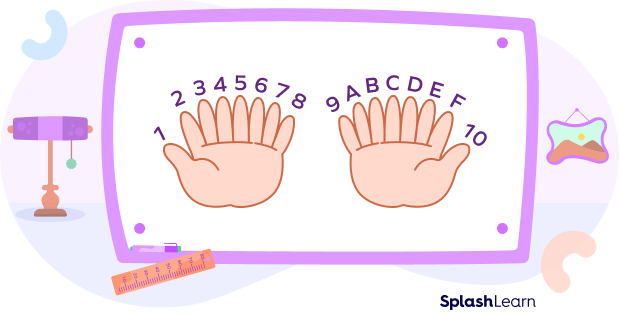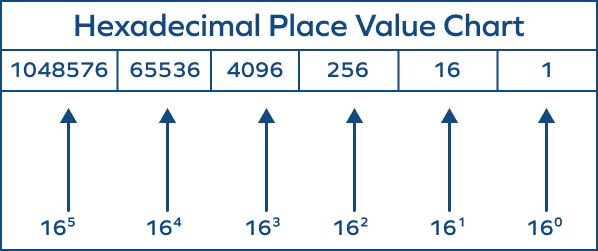
What Is the Hexadecimal to Decimal Conversion?
The hexadecimal to decimal conversion is used to convert numbers from the base-16 number system to base-10 number system.
What Is the Hexadecimal Number System?
The base of a hexadecimal number system is 16. It uses the 16 symbols given by 0, 1, 2, 3, 4, 5, 6, 7, 8, 9, A, B, C, D, E, F to write all the numbers. The place values in the hexadecimal number system are defined in terms of powers of 16.
What Is the Decimal Number System?
Decimal number system is a base-10 number system that uses digits from 0 to 9 for representing a number with base 10. The place values are defined in terms of powers of 10.
Hexadecimal to Decimal Chart
The decimal values for the digits 0 to 9 remain the same, while the letters A to F represent decimal values 10 to 15, respectively. This table is helpful in converting hexadecimal numbers to decimal.
| Hexadecimal | Decimal (Equivalent Value) |
|---|---|
| 0 | 0 |
| 1 | 1 |
| 2 | 2 |
| 3 | 3 |
| 4 | 4 |
| 5 | 5 |
| 6 | 6 |
| 7 | 7 |
| 8 | 8 |
| 9 | 9 |
| A | 10 |
| B | 11 |
| C | 12 |
| D | 13 |
| E | 14 |
| F | 15 |
Recommended Games
How to Convert Hexadecimal to Decimal
Step 1: Assign decimal values to each hexadecimal digit using the table given. The decimal values for the digits 0 to 9 remain the same, while the letters A to F represent decimal values 10 to 15, respectively.
Step 2: Starting from the rightmost digit, multiply each digit by the corresponding power of 16 (16 raised to the power of its position). The rightmost digit has a position of 0, the next digit to the left has a position of 1, and so on.

Step 3: Sum up the products obtained in step 2 to get the decimal equivalent.
Recommended Worksheets
Hexadecimal to Decimal Conversion Examples
Let’s discuss a few examples to understand the steps we discussed in the previous section.
Example 1: Convert $(36)_{16}$ into decimal form.
$(3 \times 6)_{16} = (3 \times 16^{1}) + (6 \times 16^{0})$
$(36)_{16} = 3 \times 16 + 6$
$(36)_{16} = 48 + 6$
So, $(36)_{16} = (54)_{10}$
Example 2: $(2A5D)_{16}$
In this example, we will first obtain the decimal equivalent for the symbol A and D from the conversion table given below.
A = 10, D = 13
Thus, $(2A5D)_{16} = (2 \times 16^{3})+(10 \times 16^{2}) + (5 \times 16^{1}) + (13 \times 16^{0})$
$(2A5D)_{16} = (2 \times 4096) + (10 \times 256) + (5 \times 16) + (13 \times 1)$
$(2A5D)_{16} = (10845)_{10}$
Facts about Hexadecimal to Decimal Conversion
- To convert a hexadecimal number to decimal, each digit is multiplied by the corresponding power of 16 and then the products are added together. The rightmost digit represents the units place, the next digit to the left represents the 16s place, the next digit represents the 256s place, and so on.
- The decimal equivalent of the hexadecimal digit “A” is 10, “B” is 11, “C” is 12, “D” is 13, “E” is 14, and “F” is 15.
- Hexadecimal numbers are often prefixed with “0x” to indicate that they are in the hexadecimal format. For example, 0x5AB represents the hexadecimal number 5AB.
- In the hexadecimal to decimal conversion, it is important to know the powers of 16.
Here are the first six powers of 16 starting from 0.
160 = 1
161 = 16
162 = 256
163 = 4,096
164 = 65,536
165 = 1,048,576 - Hex color code, also known as hexadecimal color code, is a representation of colors using a combination of six hexadecimal digits. The format of a hex color code is #RRGGBB, where RR represents the intensity of red, GG represents the intensity of green, and BB represents the intensity of blue. For example, #FF0000 represents pure red.
Conclusion
In this article, we learned about hexadecimal to decimal conversion. Understanding this conversion allows us to work with hexadecimal numbers more efficiently. Let’s reinforce our knowledge with practice examples and MCQs for better comprehension. Happy converting!
Solved Examples on Hexadecimal to Decimal Conversion
1. Convert (4B6)16 into a decimal system.
Solution:
In the Hexadecimal system,
4 = 4, B = 11, and 6 = 6
$(4B6)_{16} = (4 \times 16^{2}) + (11 \times 16^{1}) + (6 \times 16^{0})$
$(4B6)_{16} = (4 \times 256) + (11 \times 16) + (6 \times 1)$
$(4B6)_{16} = 1024 + 176 + 6$
$(4B6)_{16} = (1206)_{10}$
2. What is the value of $(5D)_{16}$ in the decimal system?
Solution:
5 = 5 and D = 13
$(5D)_{16} = (5 \times 16^{1}) + (13 \times 16^{0})$
$(5D)_{16} =80 + 13$
$(5D)_{16} = (93)_{10}$
3. Convert $(FA9)_{16}$ into a decimal system.
Solution:
F = 15, A = 10 and 9 = 9
$(FA9)_{16} = (15\times 16^{2}) + (10 \times 16^{1}) + (9 \times 16^{0})$
$(FA9)_{16} = 15 \times 256 + 10 \times 16 + 9$
$(FA9)_{16} = 3840 + 160 + 9$
$(FA9)_{16} = (4009)_{10}$
4. What is the value of $1B8E_{16}$ in the decimal system?
Solution:
1 = 1, B = 11 , 8 = 8 and E = 14
$(1B8E)_{16} = (1\times 16^{3}) + (11\times 16^{2}) + (8 \times 16^{1}) + (14 \times 16^{0})$
$(1B8E)_{16} = (1 \times 4096) + (11 \times 256) + (8 \times 16) + 14$
$(1B8E)_{16} = 4096 + 2816 + 128 + 14$
$(1B8E)_{16} = (7054)_{10}$
5. Convert $5CD81_{6}$ in the decimal system.
Solution:
5 = 5, C = 12, D = 13, and 8 = 8
$(5CD8)_{16} = (5 \times 16^{3}) + (12\times 16^{2}) + (13 \times 16^{1}) + (8 \times 16^{0})$
$(5CD8)_{16} = (5 \times 4096) + (12 \times 256) + (13 \times 16) + 8$
$(5CD8)_{16} = 20,480 + 3,072 + 208 + 8$
$(5CD8)_{16} =(23,768)_{10}$
Practice Problems on Hexadecimal to Decimal Conversion
Hexadecimal to Decimal Conversion - Steps, Chart, Facts, Examples
The hexadecimal number $16_{16}$ represents the decimal number ____ .
$16_{16} = 1 \times 16^{1} + 6 \times 16^{0}$
$16_{16} = 16 + 61$
$16_{16} = 22_{10}$
On converting $(6AB)_{16}$ in the decimal system, we get ___.
$(6AB)_{16} = (6 \times 16^{2} + 10 \times 16^{1} + 11 \times 16^{0})$
$(6AB)_{16} = 6 \times 256 + 10 \times 16 + 11$
$(6AB)_{16} =(1707)_{10}$
On converting $(CD6)_{16}$ in the decimal system, we get ___.
$(CD6)_{16} = (12 \times 16^{2} + 13 \times 16^{1} + 6 \times16^{0})$
$(CD6)_{16} = 12 \times 256 + 13 \times 16 + 6$
$(CD6)_{16} = 3072 + 208 + 6$
$(CD6)_{16} =(3286)_{10}$
Convert $(187F)_{16}$ in the decimal system.
$(187F)_{16} = (1 \times 16^{3} + 8 \times 16^{2} + 7 \times 16^{1} + 15 \times 16^{0})$
$(187F)_{16} =4096 + 8 \times 256 + 7 \times 16 + 15$
$(187F)_{16} = 4096 + 2048 + 112 + 15$
$(187F)_{16} = (6271)_{10}$
Frequently Asked Questions on Hexadecimal to Decimal Conversion
What is the hexadecimal to decimal formula?
There’s no specific formula for the conversion. To convert a hexadecimal number into decimal, multiply each digit with the corresponding power of 16 (starting from the rightmost digit multiplied by 160). Finally add up the products.
What is the difference between a hexadecimal system and an octal system?
We use the base of a hexadecimal system as 16. Each digit is 16 times more significant than the previous digit. We use the base of a binary system as 8. Each digit is 8 times more significant than the previous digit.
How do you convert from decimal to hexadecimal system?
Divide the decimal number by 16 repeatedly till you get the quotient value equal to zero. At every step, note down the quotient and remainder. To find the equivalent hexadecimal number, write the remainders in the reverse order (bottom to top).
What is the hexadecimal number FFFF in decimal?
Hexadecimal notation FFFF equals 65535 in decimal value




































